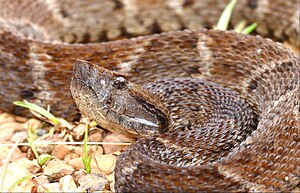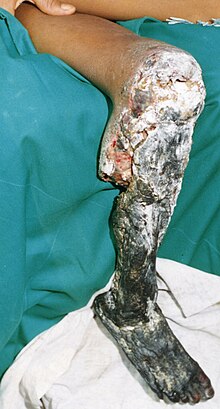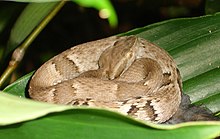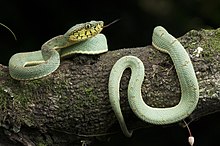American lance vipers
| American lance vipers | ||||||||||||
|---|---|---|---|---|---|---|---|---|---|---|---|---|

Common Lance Viper ( Bothrops atrox ) |
||||||||||||
| Systematics | ||||||||||||
|
||||||||||||
| Scientific name | ||||||||||||
| Bothrops | ||||||||||||
| Wagler , 1824 |
The American lance vipers ( Bothrops ) are a genus of snakes from the subfamily of pit vipers . The genus occurs with about 37 species in South and Central America. All species are poisonous, the more common species with a larger distribution area are among the most medically relevant venomous snakes . Deaths are rare to common, depending on the species.
features
anatomy
American lance vipers are medium-sized to very large, relatively slender pit vipers, the broad head is clearly set off from the neck. Most species have a sharp-edged canthus and a non-elongated mouth tip. The three exceptions are B. lojanus and B. barnetti , in which the tip of the mouth is slightly bent upwards, and B. ammodytoides , which has a nose appendage. The smallest species reach total lengths of 50–70 cm, the largest over 2 m. Females become significantly larger and heavier than males.
Scaling
The species show five to twelve weakly keeled supraocularia . The number of supralabials is usually seven to nine, the number of infralabials is usually nine to eleven. The number of abdominal scales ( ventral shields ) varies between 139 and 240, the number of subcaudalia between 30 and 86 and the number of dorsal rows of scales in the middle of the body between 21 and 29.
coloring
The basic color of the top is usually brown or gray. Most species show light-edged, dark brown, trapezoidal or triangular markings on both sides of the back, the wide and downwardly open base of which points towards the belly. The points of the drawings can meet in the middle of the spine, so that the spine shows a very conspicuous X-mark, or they can be partially or completely offset from one another. On the tail, this drawing is usually getting narrower and consists mostly only of light gray lines on a dark background. Some species in southern South America are drawn more intensely and with more contrast and also show strong stripes on the head.
distribution and habitat
American lanceolers are largely restricted to South America, only two of the 37 or so species also reach Central America ( Bothrops asper and B. punctatus ). Most species are restricted to lowlands and occur at altitudes of up to 1,500 m, but a number of species are very adaptable and inhabit a range of habitats that range from desert-like coastal plains to mountain rainforests at an altitude of 2,500 m. Some species are also common in densely populated areas.
Systematics
The number of species and subspecies has been controversial for a long time, Campbell and Lamar recognize 36 species and an additional one that has not yet been described:
- Bothrops alcatraz Marques, Martins & Sazima 2002
- Bothrops alternatus Duméril, Bibron & Duméril 1854
- Patagonian Lance Viper ( Bothrops ammodytoides ) Leybold 1873
- Bothrops andianus Amaral 1923
- Terciopelo lance viper ( Bothrops asper ) Garman 1884
- Bothrops atrox Linnaeus 1758
- Bothrops barnetti Parker 1938
- Bothrops brazili Hoge 1954
- Bothrops caribbaeus Garman 1887
- Bothrops cotiara Gomes 1913
- Bothrops erythromelas Amaral 1923
- Bothrops fonsecai Hoge & Belluomini 1959
- Island lance viper ( Bothrops insularis ) Amaral 1922
- Bothrops itapetiningae Boulenger 1907
- Jararaca lance viper ( Bothrops jararaca ) Wied-Neuwied 1824
- Bothrops jararacussu Lacerda 1884
- Bothrops Jonathani Harvey 1994
- Bothrops lanceolatus Bonnaterre 1790
- Bothrops leucurus Wagler 1824
- Bothrops lojanus Parker 1930
- Bothrops marajoensis Hoge 1966
- Bothrops moojeni Hoge 1966
- Bothrops monsignifer Timms et al., 2019
- Bothrops muriciensis Ferrarezzi & Freire 2001
- Bothrops osbornei Freire-Lascano 1991
- Bothrops pictus Tschudi 1845
- Bothrops pirajai Amaral 1923
- Bothrops punctatus Garcia 1896
- Bothrops roedingeri Mertens 1942
- Bothrops sanctaecrucis Hoge 1966
- Bothrops sazimai Barbo et al. 2016
- Bothrops venezuelensis Sandner-Montilla 1952
The greatest problems with the species classification occur with the so-called Bothrops neuwiedi complex, a group of Bothrops populations in eastern and central South America. These populations have all been assigned to the species B. neuwiedi until recently , so up to 12 subspecies have been recognized for this species. Xavier da Silva revised this complex on the basis of morphological features, and split the complex into 7 types:
- Bothrops neuwiedi Wagler 1824
- Bothrops diporus Cope 1862
- Bothrops lutzi Miranda-Ribeiro 1915
- Bothrops marmoratus da Silva & Rodrigues 2008
- Bothrops mattogrossensis Amaral 1925
- Bothrops pauloensis Amaral 1925
- Bothrops pubescens Cope 1870
- Bothrops sonene Carrasco, Grazziotin, Farfán, Koch , Ochoa, Scrocchi, Leynaud, Chaparro, 2019
A molecular genetic investigation that includes all species or taxa of the genus Bothrops is not yet available. In the most comprehensive molecular genetic work to date, which took 28 species or forms of the genus into account, the following cladogram was developed:
|
|
|
|||||||||||||||||||||||||||||||||||||||||||||||||||||||||||||||||||||||||||||||||||||||||||||||||||||||||||||||||||||||||||||||||||||||
|
|
Lifestyle and diet
Almost all species of the genus are predominantly nocturnal. Occasionally diurnal species are, on the one hand, that inhabit higher altitudes, and, on the other, species of the dense tropical lowland rainforest on cloudy days or when it rains. Most of the species live on the ground, but a number of species also often climb into low bushes or trees. Only a few species are more tree-living, especially B. insularis , B. jararaca , B. lanceolatus and B. punctatus .
Most species eat cold-blooded animals such as invertebrates, reptiles and amphibians as young and switch to warm-blooded vertebrates such as birds and mammals as soon as they reach a sufficient size.
In many species, a vibration of the tail tip can be observed when provoked. This generates a rattling noise when it comes into contact with fallen leaves from trees and serves as a warning.
Reproduction
All species are viviparous, young animals are mostly born in the rainy season. The reproduction is size dependent. The smaller species have a maximum of about 20 young per litter; for the largest species, B. asper , a maximum of 86 young animals were found in one litter.
Poison
The toxin mixtures of pit vipers are by far komplexesten natural poisons. They contain a mixture of enzymes , low molecular weight polypeptides , metal ions and other components whose function has so far hardly been understood. The effects of these poisons are correspondingly diverse. The venom of the American lanceolate causes a whole range of symptoms, a distinction being made between local and whole-body ( systemic ) symptoms.

Local effects
The poison contains highly protein-degrading enzymes ( metalloproteinases and phospholipase A 2 ) that destroy tissue . Typical local symptoms are above all severe pain, redness and swelling that quickly spreads to the entire bitten limb and the adjacent trunk, as well as small or large blisters that contain clear or blood- serous fluid. Often necroses develop , especially of the muscle tissue. If treatment is not initiated or initiated too late, the affected limbs must occasionally be amputated because of the necrosis. Further permanent damage is functional impairment or loss due to muscle wasting ( atrophy ), permanent muscle shortening and paralysis of peripheral nerves.
Systemic effects
The poison has a hemolytic effect and, due to metalloproteinases, has a hemorrhagic effect (destroys blood vessels). The main hemorrhagin in the venom of the species is jararhagin, a zinc- containing metalloproteinase. The poison causes a change in the blood coagulation precursor fibrinogen through thrombin-like enzymes ( TLEs ) and thereby a pathological activation of blood coagulation . This leads to the rapid consumption of the coagulation factors via further steps and therefore has an anticoagulant effect . The syndrome is known as Disseminated Intravascular Coagulopathy (DIC). The patients bleed from the bite site, from unhealed scars, mosquito bites and oral mucous membranes and internal bleeding occurs. The poison is apparently also directly toxic to the kidneys. Additional complications arise from infections from the bacterial fauna contained in the snake's mucous membranes. Deaths are due to acute kidney failure, cerebral haemorrhage, and sepsis.
Epidemiology
American lance snakes are by far the most medically relevant snakes in South and Central America. Fatal poisoning is rare to common, depending on the type.
Medical use
The poison of the lance viper species Bothrops atrox and Bothrops jararaca contains, among other things, the enzyme reptilase , which is used in medicine for both diagnostic and therapeutic purposes because of its effect on blood coagulation . The pentapeptide BPP 5a (Bradykinin Potentiating Peptide), first discovered in the venom of Bothrops jararaca , inhibits the angiotensin-converting enzyme and led to the development of the ACE inhibitor class of drugs .
swell
Individual evidence
- ↑ Juan Timms, Juan C. Chaparro, Pablo J. Venegas, David Salazar-Valenzuela, Gustavo J. Scrocchi, Jairo Cuevas, Gerardo C. Leynaud and Paola A. Carrasco. 2019. A New Species of Pitypen of the Genus Bothrops (Serpentes: Viperidae: Crotalinae) from the Central Andes of South America. Zootaxa. 4656 (1); 99-120. DOI: 10.11646 / zootaxa.4656.1.4
- ^ V. Xavier da Silva: The Bothrops Neuwiedi Complex. In: Jonathan A. Campbell, William W. Lamar: The Venomous Reptiles of the Western Hemisphere. Comstock; Ithaca, London; 2004: pp. 410-422
- ↑ Silva, VX there; Rodrigues, MT: Taxonomic revision of the Bothrops neuwiedi complex (Serpentes, Viperidae) with description of a new species. Phyllomedusa 7 (1), 2008: pp. 45–90 Description of the species in the reptile database
- ↑ Paola A. Carrasco, Felipe G. Grazziotin, Roy Santa Cruz Farfán, Claudia Koch, José Antonio Ochoa, Gustavo J. Scrocchi, Gerardo C. Leynaud and Juan C. Chaparro. 2019. A New Species of Bothrops (Serpentes: Viperidae: Crotalinae) from Pampas del Heath, southeastern Peru, with Comments on the Systematics of the Bothrops neuwiedi species group. Zootaxa. 4565 (3); 301-344. DOI: 10.11646 / zootaxa.4565.3.1
- ^ W. Wüster, MG Salomão, JA Quijada-Mascareñas, RS Thorpe and BBBS P: Origin and evolution of the South American pitocket fauna: evidence from mitochondrial DNA sequence analysis. In: GW Schuett, M. Höggren, ME Douglas & HW Greene (eds): Biology of the Vipers. Eagle Mountain Publishing, Eagle Mountain, Utah, 2002: pp. 111-128.
- ↑ Ludwig Trutnau: Snakes in the Terrarium Vol. 2: Poisonous snakes . Verlag Ulmer, Stuttgart 1998, ISBN 3-800-1705-23 .
- ↑ Ralph Holl & Katharina Holl: New Medicines - Animal Poisons as Lead Structures, Pharmazeutische Zeitung, edition 43/2017, GOVI Verlag, 2017.
literature
- David A. Warrell: Snakebites in Central and South America: Epidemiology, Clinical Features, and Clinical Management . In: Jonathan A. Campbell, William W. Lamar: The Venomous Reptiles of the Western Hemisphere. Comstock; Ithaca, London. 2004. ISBN 0-8014-4141-2 : pp. 709-761.
- Jonathan A. Campbell, William W. Lamar: The Venomous Reptiles of the Western Hemisphere. Comstock; Ithaca, London; 2004 ISBN 0-8014-4141-2

